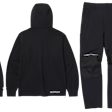
Weather extremes bring the need for a construction work jacket that offers comfort while executing job tasks. Insulation plays a key role in doing so.
For workers in most parts of the U.S., impending cold weather will dictate that choice. This IRONPROS story emphasizes the importance of making the proper choice to prevent hypothermia.
Insulation is thermal resistance between the skin and the surface of the clothing. Factors include fabric type, material, thickness and how the fabric works to trap the air.
The more air that is trapped, the higher the insulating factor.
As this IRONPROS story notes, the choice between synthetic or natural insulation takes several factors into account.
One is that clothing should retain a person’s own natural body heat. Consider how cold it may be on the given workday and if conditions include rain, snow, wind, or any combination of these.
Work functions could be stationery or include significant moving about. Some people may have allergies to certain materials.
Another option: a moisture-wicking base layer can be worn to keep sweat away from the skin, while an insulating layer provides warmth and a waterproof and windproof layer protects against the elements.
Goose or duck down is natural insulation that offers optimal warmth. Down is considered best for cold, dry environments. Down can be treated with a water-resistant coating.
It also is light in weight – although down of a lesser quality as indicated by a lower fill power rating (800 to 900 being the highest) may make the jacket feel heavier.
Wool and alpaca wool provide insulation even under wet conditions, offering moisture resistance and warmth while keeping the skin’s surface cool, dry, and odor-free. Wool also is wind-proof and flame-retardant.
Benefits of wool
This IRONPROS story further explains the benefits of wool.
For those who may find wool to be too itchy, Merino wool is considered soft and itch-free.
Other natural insulation fibers include hemp, sourced from the hemp plant, and considered insulating and durable. Hemp is often used as part of a blend rather than as a primary insulating material. Hemp has natural moisture-wicking properties and is resistant to mold and mildew.
While wool, cotton, and hemp provide significant breathability, they may not provide the same level of warmth in extreme cold as down or synthetic insulation.
Cotton is considered suitable for moderate climates; not so much so for cold or wet weather.
Synthetic insulation is created from man-made fibers and is tightly woven to create pockets of air between the fibers. Synthetic materials can be treated for water- and odor-resistance. In contrast to natural insulation, synthetic insulation often holds up better in wet and humid conditions and dries faster.
The tightly-woven fibers of polyester prevents moisture from getting through the fabric. Polyester material can fight off water either through a tight weave or a chemical coating deflecting water. It also is lightweight and breathable and can be comfortably worn in cold weather.
More information on polyester can be found in this IRONPROS article.
Thinsulate also is lightweight. It effectively traps heat and is compressible. It provides an optimal warmth-to-weight ratio and moisture resistance. It continues to provide insulation when wet.
PrimaLoft offers advantages in cold, wet environments. It is designed to mimic the warmth of down fabric while providing water resistance. Unlike down fabric, it retains warmth when wet. It is water-resistant, breathable, and lightweight.
Fleece, made from polyester, mimics the warmth and feel of wool but may not be as breathable.
Another consideration is if an insulated jacket has a hood with drawcords and how that hood interacts with a helmet and hearing protection.
While synthetic insulation can be made from petroleum-based products, creating environmental concerns regarding plastic production and microplastics, there are options using recycled materials to minimize environmental impact.
Animal welfare concerns have been raised over the use of down insulation. Some manufacturers are offering ethically-sourced down, such as Responsible Down Standard-certified. While wool involves animal farming, it is biodegradable and renewable.
This IRONPROS article addresses how often a winter work jacket should be washed and the signs and materials to consider.
As with any apparel choice when working on a construction site, consult the safety manager to ensure it is the best choice.
















